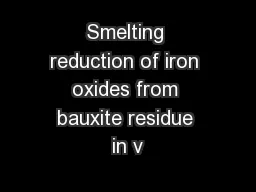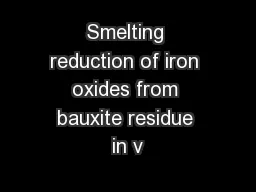PPT-Smelting reduction of iron oxides from bauxite residue in v
Author : liane-varnes | Published Date : 2017-06-17
C R Borra B Blanpain Y Pontikes K Binnemans T Van Gerven Bauxite residue is a waste generated in Bayers Process 1525 tonton alumina Occupies land harmful
Presentation Embed Code
Download Presentation
Download Presentation The PPT/PDF document "Smelting reduction of iron oxides from b..." is the property of its rightful owner. Permission is granted to download and print the materials on this website for personal, non-commercial use only, and to display it on your personal computer provided you do not modify the materials and that you retain all copyright notices contained in the materials. By downloading content from our website, you accept the terms of this agreement.
Smelting reduction of iron oxides from bauxite residue in v: Transcript
Download Rules Of Document
"Smelting reduction of iron oxides from bauxite residue in v"The content belongs to its owner. You may download and print it for personal use, without modification, and keep all copyright notices. By downloading, you agree to these terms.
Related Documents














